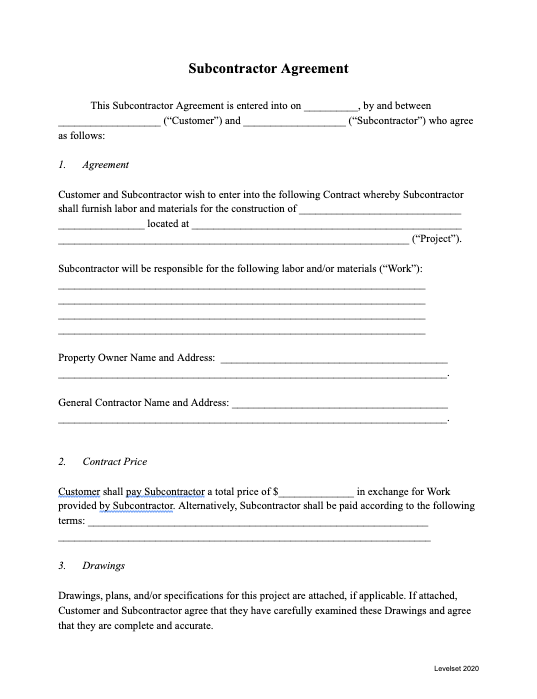
A subcontractor agreement is a contract between a subcontractor and another contractor that defines a specific portion of work on a larger construction project. Since a subcontractor doesn’t have an agreement directly with the property owner, this contract with another contractor (often a general contractor) is essential for establishing expectations and managing risk.
Subcontractors have the right to get paid for their work whether or not they have a written agreement. However, getting the rights and responsibilities down on paper provides another level of protection that makes it much more likely to get paid and prove that a job was completed according to the terms of an agreement.
Below, we’ll give you the important details about subcontractor agreements and provide a template you can use as a basis for entering into work with other contractors
Free subcontractor agreement template
Our free subcontractor agreement template offers a starting point for putting together a contract. As always, you may need to consult with an attorney to confirm that your contract complies with any state or municipal laws that may apply to your project.

Free Subcontractor Agreement Template
What subcontractors need to know about construction contracts
A building project may be governed by one or more construction agreements, which define the roles, responsibilities, and rights of each party to the contract. The general contractor typically has an agreement directly with the property owner, known as the prime contract. When the GC outsources work to subs, they will create separate subcontracts for each party they hire.
However, the subcontract isn’t always necessarily separate from the GC’s contract. A subcontractor is often required to comply with provisions in the prime contract through flow-down clauses. These clauses can hold a subcontractor responsible for things that aren’t explicitly detailed in their contract.
If a subcontract incorporates the prime contract by reference, then the sub is entitled to request a copy of the GC’s contract as well.
Keep in mind that a contract is often more than a single document – it can actually include a variety of project documents that cover specific details of the work, like specifications or special conditions. All of these documents together make up the full construction contract.
8 things a subcontractor agreement should include
Subcontractor agreements don’t need to be overly complicated or lengthy, but they do need to include some basic information that helps ensure clear expectations about project scope, potential disputes, and eventual payment.
Below, we’ve listed eight pieces of information that are included in most subcontractor agreements.
1. Business information
Include names, businesses names, and contact information for both the subcontractor and the hiring contractor.
Why it matters: Personal and contact information can help increase transparency and improve communication from the outset of a project.
2. Scope of work
Provide a scope of work that details all of the subcontractor’s work, including any materials or equipment that the subcontractor must provide to the project. This section of the contract will likely include some type of project schedule—including the effective date of the contract, the date work should start, and the expected completion date.
Why it matters: A well-defined scope of work and schedule lays out clear expectations for both the hiring contractor and the subcontractor.
3. Payment terms
Define the terms of payment for the contract, often an hourly rate or a flat fee. Different types of subcontractor agreements may have differing approaches to payment terms, but accuracy and transparency are especially important for this part of the contract. For instance, the contract should define how progress payments will be made and how subcontractors submit payment applications.
Why it matters: Clear terms about payment offer protection for all parties involved in the subcontractor agreement.
Related: Read the guide to payment provisions in the AIA A401 subcontractor agreement
4. Change orders
Explain how subcontractors should handle change orders, including how to request a change order and what the approval process entails. With a proper change order process in place, subcontractors will have a more clearly defined scope of work when the need for changes arises.
Why it matters: Change orders are a fact of life with construction, so defining the process ensures that subcontractors get the job done right and don’t have to do extra work for free.
5. Licensing and insurance coverage
Describe insurance and licensing requirements that subcontractors need to meet in order to qualify for the project. Generally, this would mean that subcontractors must hold a valid contractor license in the state. Additionally, most subcontractors should already have insurance, but defining the specific requirements is important.
Why it matters: Performing work without the proper license or insurance can jeopardize lien rights, so subcontractors can’t simply rely on the contract requirements here. They must also follow the statutory requirements for the work they are performing.
6. Dispute resolution
Detail the process for resolving construction claims and disputes. For example, many contracts include a written notice requirement as well as a procedure to resolve claims. Furthermore, some contracts specify processes for arbitration or mediation under an alternative dispute resolution (ADR) clause.
Why it matters: Conflicts and disputes arise on many construction jobs, even when everyone has the best intentions. Well-defined protocols for resolving disputes are crucial for a successful job.
7. Termination clause
Termination clauses outline the reasons, notice requirements, and duties for the termination of the agreement. The termination provisions can include a clause for termination for cause, termination for convenience, or both.
Why it matters: Everyone involved in a subcontractor agreement needs a clear understanding of how and why the agreement can be terminated.
8. Flow-down provisions
Supply details about flow-down provisions, which are used to incorporate some or all of the rights and responsibilities from the prime contract. Whenever a subcontractor agreement includes flow-down provisions, the subcontractor should also get a copy of the prime contract.
Why it matters: Flow-down provisions can simplify terms for the hiring contractor, but subcontractors who agree to flow-down provisions need to read the prime contract carefully.
Red flags in a subcontract
Subcontractors face different challenges when it comes to their contract and payments on a project due their position in the construction payment chain. For subs to collect payment, the money will need to flow down from the lender (if there is one), the owner, and then through the GC—and potentially even additional layers of subcontractors.
Understanding red-flag provisions on a contract can help subcontractors ensure they get paid for their work.
Here is a list of a few clauses to look out for, with links to more detailed discussions of each:
- Contingent payment clauses: “pay-if-paid” & “pay-when-paid” clauses
- Indemnification clauses
- No-lien clauses
- No damages for delay clauses
- Subordination clauses
A subcontractor agreement doesn’t need to be overly complex or unfair to any party on a project. A simple, straightforward, and easy-to-understand subcontract will be just fine in most situations.
Regardless of the contract you sign, make sure that you take care to protect your lien rights so that you’re paid fairly for the work you do.
